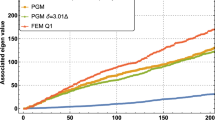Abstract
A method is presented which enables the global enrichment of the approximation space without introducing additional unknowns. Only one shape function per node is used. The shape functions are constructed by means of the moving least-squares method with an intrinsic basis vector and weight functions based on finite element shape functions. The enrichment is achieved through the intrinsic basis. By using polynomials in the intrinsic basis, optimal rates of convergence can be achieved even on distorted elements. Special enrichment functions can be chosen to enhance accuracy for solutions that are not polynomial in character. Results are presented which show optimal convergence on randomly distorted elements and improved accuracy for the oscillatory solution of the Helmholtz equation.
Similar content being viewed by others
References
Belytschko T, Liu WK, Moran B (2000) Nonlinear finite elements for continua and structures. Wiley, Chichester
Zienkiewicz OC, Taylor RL (2000) The finite element method, vols. 1–3. Butterworth-Heinemann, Oxford
Babuška I, Melenk JM (1997) The partition of unity method. Int J Numer Methods Eng 40:727–758
Melenk JM, Babuška I (1996) The partition of unity finite element method: basic theory and applications. Comput Methods Appl Mech Eng 139:289–314
Strouboulis T, Babuška I, Copps K (2000) The design and analysis of the generalized finite element method. Comput Methods Appl Mech Eng 181:43–69
Strouboulis T, Copps K, Babuška I (2001) The generalized finite element method. Comput Methods Appl Mech Eng 190:4081–4193
Belytschko T, Moës N, Usui S, Parimi C (2001) Arbitrary discontinuities in finite elements. Int J Numer Methods Eng 50:993–1013
Moës N, Dolbow J, Belytschko T (1999) A finite element method for crack growth without remeshing. Int J Numer Methods Eng 46:131–150
Oden JT, Duarte CA, Zienkiewicz OC (1998) A new cloud-based hp finite element method. Comput Methods Appl Mech Eng 153:117–126
Tian R, Yagawa G (2005) Generalized nodes and high-performance elements. Int J Numer Methods Eng 64: 2039–2071
Chen G, Ohnishi Y, Ito T (1998) Development of high-order manifold method. Int J Numer Methods Eng 43:685–712
Belytschko T, Gu L, Lu YY (1994) Fracture and crack growth by element free galerkin methods. Model Simul Mater Sci Eng 2:519–534
Lancaster P, Salkauskas K (1981) Surfaces generated by moving least squares methods. Math Comput 37:141–158
Belytschko T, Krongauz Y, Organ D, Fleming M, Krysl P (1996) Meshless methods: an overview and recent developments. Comput Methods Appl Mech Eng 139:3–47
Fries TP, Matthies HG (2003) Classification and overview of meshfree methods. Informatikbericht-Nr. 2003-03, Technical University Braunschweig, (http://opus.tu-bs.de/opus/volltexte/2003/418/), Brunswick
Fries TP, Belytschko T (2006) The intrinsic XFEM: a method for arbitrary discontinuities without additional unknowns. Int J Numer Methods Eng. DOI 10.1002/nme.1761
Cho YS, Jun S, Im S, Kim HG (2005) An improved interface element with variable nodes for non-matching finite element meshes. Comput Methods Appl Mech Eng 194: 3022–3046
Cho YS, Im S (2006) MLS-based variable-node elements compatible with quadratic interpolation. Part I: Formulation and application for non-matching meshes. Int J Numer Methods Eng 65:494–516
Cho YS, Im S (2006) MLS-based variable-node elements compatible with quadratic interpolation. Part II: Application for finite crack element. Int J Numer Methods Eng 65: 517–547
Belytschko T, Lu YY, Gu L (1994) Element-free Galerkin methods. Int J Numer Methods Eng 37:229–256
Huerta A, Fernández-Méndez S (2000) Enrichment and coupling of the finite element and meshless methods. Int J Numer Methods Eng 48:1615–1636
Brooks AN, Hughes TJR (1982) Streamline upwind/ Petrov-Galerkin formulations for convection dominated flows with particular emphasis on the incompressible Navier-Stokes equations. Comput Methods Appl Mech Eng 32: 199–259
Author information
Authors and Affiliations
Corresponding author
Rights and permissions
About this article
Cite this article
Fries, TP., Belytschko, T. The intrinsic partition of unity method. Comput Mech 40, 803–814 (2007). https://doi.org/10.1007/s00466-006-0142-x
Received:
Accepted:
Published:
Issue Date:
DOI: https://doi.org/10.1007/s00466-006-0142-x




